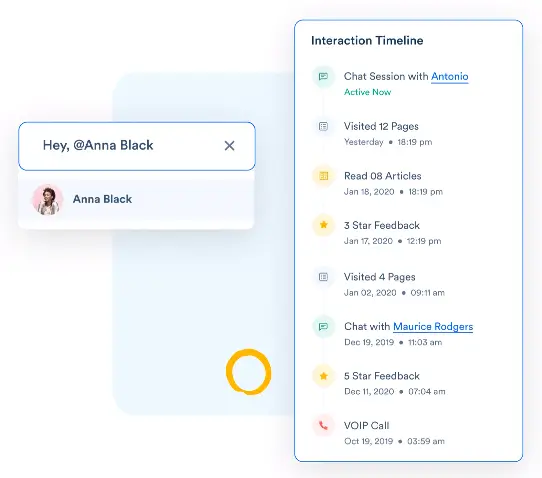6 Tips on How To Treat Customers more than Sales [en]
- July 22, 2021
- Posted by: Siriluck Sukitphittayanon
- Category: Articles-EN


The companies that customers like to do business with have something in common: they focus more on their customers than on generating sales. It’s normal for them to want to make sales and increase their revenue but it only works if they solve the problem the customer brings without showing that it’s all about money.
1. Make conversations more personal
Personalization is the single most effective and amazingly easy way to become more customer centric and keep retention rates high. Remember visitors with cookies if you have a website, track the products they like and the time they spend on each page, the frequency of page visits, and so on. Information like this can be helpful when requesting support.
Even offline, connecting with your customers over what you’re trying to sell will make you memorable. Little things like remembering their first name, saying “thank you” and so much more.
Customers enjoy being treated like regulars in stores they visit frequently, and this applies to online stores as well. Looking at your customers as humans and not statistical can help you deliver exemplary customer service.
2. Invest in Live Chat Software for Real-Time Support
Customer care is the structure in which your entire business is built. According to American Express, more than 66% of customers are willing to spend more on a brand that offers better customer care. Live chat appears to be an important part of delivering a great customer experience, and for several reasons. Taking advantage of Live Chat can enhance customer support in the following ways:
Optimize: Using ads may temporarily increase your conversions. But this strategy isn’t enough for sustainable growth. Yes, conversion rate is an important KPI for profitability, but you also need to factor in effective customer service. You can add a keypad (Sweetspot) using Live Chat support software. It is 20-50% cheaper than phone support and save everyone’s time.

Live Chat support is appreciated by everyone and this is proven by surveys as well. Live Chat has a customer satisfaction rate of over 90% and no wonder it’s fast, free, chatting and easy to use.
Live Chat helps you collect customer information, which is today’s most valuable resource. By adding a highlight to your brand, this information will help you get closer to your customers. personal experience can penetrate the thick layer of cyberspace between you and them
Live Chat works for all types of businesses and gives your brand a human feel to it, even transcripts can be used to train your agents to provide even better customer care.
3. Show Respect to Customers
If you value good customer care, respecting your customers is extremely important. Especially their data without much yield, so it is necessary to take a customer-centric approach and build mutually beneficial relationships.Here are some ideas:
Solve their problems:
Trying to solve a customer’s problem can be the best way to show that you care about them. Acknowledge the issues they face, apologize, fix them as soon as possible and make sure it doesn’t happen again.
Request permission to collect information:
Whether you communicate with customers via email, telephone, or the web, you need permission to collect their data. Being attentive shows that you respect their privacy very much.
Keep the Promise:
It’s a disaster to assure a customer of something and not do it if you’ve set a time frame to fix some issues and complete them within that timeframe. Acting quickly shows that you respect their time and build respect for your service.
There are many ways you can show respect to your customers. Responding promptly, owning up to your mistakes and treating them the way you want to be treated is another way you can make your customers feel valued.
4. Implement a customer-centric strategy across the organization.
Young entrepreneurs and entrepreneurs put a lot of effort into planning their investments — the products and services they will offer and how they plan to make a profit. In this time of urgency, they tend to be too focused on their internal tasks and fail to see what their customers want.
Conversely, for sales-focused businesses, focusing on a more customer-centric approach is a must. In any case, the client has to sit in the driver’s seat if you want to build and maintain a long-term relationship. This involves delivering an exemplary customer experience before and after the sale. But that’s not all — according to Deloitte, customer-centric businesses are 60% more profitable.
with this in mind Here are some things you can do:
Comprehensive user research should be the first step towards creating a customer-centric experience. You’ll need to gather insights from every platform your customers use to interact with your brand. He can unless you know what they want.
It’s always better to be present on multiple platforms. So it will be easier for your customers to reach you and engage with your brand. Answer brand questions on the platform as well as social media hints at a customer-centric mindset.
Develop a CX (Customer Experience) strategy from user research insights and then take action to improve the customer experience.
For your business to be successful, you need your customers to be at the heart of everything you do. Customize everything as your target audience likes.
5. Express gratitude
E-commerce giant Amazon has a no-questions-asked return policy. More than convenience, this is a reward for loyal customers and a reflection of gratitude on the part of the company.
But if you’re a growing business, even handwritten messages sent to your customers will make them smile. A note can be as simple as wishing a customer a good day. But it will make your service look like a private message. And customers will feel that they are more important than their money. It’s all about developing a customer-centric mindset and making them feel important. On a similar note, you can also send greetings on their special occasions, such as birthdays or anniversaries, or when your company has achieved its goals and you would like to thank those who were part of their journey.
You can also extend the service to your loyal customers. For example, Loom decided not to profit from the pandemic and offered shareable video software to institutions. free of charge, allowing them to work remotely
But those cases are rare. should not be grateful Although some companies offer gifts to customers. But a thoughtful gift at the end of the purchase is enough to set you apart. It’s a tried-and-true strategy for offering post-purchase discounts or valid gift cards for your next purchase, but the budget and process that can Repeatability is equally important.

6. Ask for opinions
Most of your customers want to advise and provide feedback and ideas to improve your products, services and overall customer experience. All you have to do is ask. Asking for their opinion means that you value their opinion and are willing to consider the issues they identify as missing. If you have a new plan or are introducing a new product You should always share with your most loyal customers.
Not just for show Learning about the quality of a company is nothing more convincing than the feedback from the customers themselves. In addition to highlighting aspects of your product and service that need improvement, it also identifies which areas are not right for customers? Which ones are least liked by customers? and why
Listening to customer feedback makes them feel more involved in your process, as if they were part of your team.
There is only one caveat: You must discuss every feedback with your team and return the results to your clients. so as not to be left in the dark Remember that every positive customer experience is directed back to you.
Conclusion
Customers are hard to come by and easy to lose. Based on the points mentioned above, such as building a customer-centric mindset and using Live Chat for customer care. You will never lose a customer through your own fault again. Your problem will turn from a low customer lifetime value (CLV) or high bounce rate to having too many customers. We all look forward to these kinds of problems.

